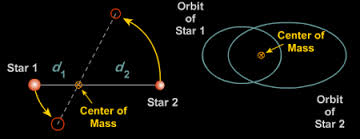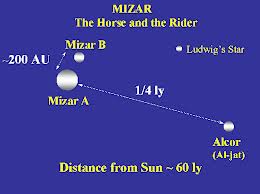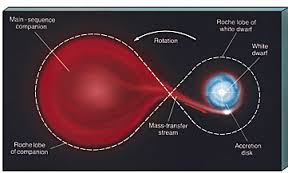Overview
Although the star we are most familiar with exists as a single star, many common stars exist in pairs or multiple star systems. More than half of all stars are possibly multiple, deduced from observations of their spectra and motion. They are bound by mutual gravitational attraction, and orbit around common points. Some stars borrow matter from one another, resulting in runaway nuclear fusion and variability.
Binary Stars
Binary stars are systems that exist when both stars orbit a common point. Some of the brightest stars that we see are actually binary systems. For example, Sirius consists of a very bright Type A main-sequence star that is about twice the mass of the sun, and a very faint white dwarf star that is collapsed to the size of the earth, but probably contains almost the same mass as the sun.
Multiple Star Systems
Multiple star systems consist of more than two stars. Usually, at least two of the stars are in a binary system and other stars orbit at different angles around the same common point. Alpha Centauri, the closest star at a little over 4 light-years, is a triple star system, with a binary yellow star. The red dwarf Proxima Centauri may be part of the same system, with a huge eccentric orbit. The North Star, Polaris, is a triple star system. The binary system stars are in such close orbit that the third star was only visible from the Hubble Space telescope. Some systems exist with six or seven stars in various complicated, unstable orbital patterns.
Matter Borrowing
If stars are close enough in a system, one star will drain matter from the other. Stars that are so close together that they change shape as they orbit have been observed in the Milky Way Galaxy and other galaxies throughout the universe. Sometimes conditions are such that one star has a less dense stellar envelope, (such as a red giant), so it can easily give up matter. If the other star has a very high density, such as a white dwarf, the matter drain can be tremendous.
Novae and Beyond
When a white dwarf captures hydrogen from its companion, the hydrogen ignites. It heats enough that hydrogen is fused into helium in a runaway CNO (carbon-nitrogen-oxygen) reaction. The runaway reaction results in a bright flash, called a nova. Novae emit energy at all levels of the electromagnetic spectrum, including gamma rays. Some stars have been observed to have outbursts every 10 to 20 years. Novae (pl. of nova) have been observed in other galaxies.
Interested in science tutoring services? Learn more about how we are assisting thousands of students each academic year.
SchoolTutoring Academy is the premier educational services company for K-12 and college students. We offer tutoring programs for students in K-12, AP classes, and college. To learn more about how we help parents and students in Bourne, MA: visit: Tutoring in Bourne, MA





